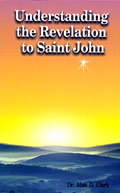Book Reviews
Understanding the Revelation ...
 8/10
8/10
By Dr. Alan D. Clark
 Ok, this is a Baha'i book, so while I highly recommend it, if you go in without knowing that, you could be surprised. Even if you're not a member of the Baha'i religion (UPDATE: as I no longer am), some of his interpretations might still intrigue you.
Ok, this is a Baha'i book, so while I highly recommend it, if you go in without knowing that, you could be surprised. Even if you're not a member of the Baha'i religion (UPDATE: as I no longer am), some of his interpretations might still intrigue you.
The gist of the Baha'i belief is that Christ did return already, in the middle of the nineteenth century, as a Persian nobleman named Baha'u'llah. This book suffers a bit from the standard logical fallacy of taking this interpretation and working backwards to prove it. Luckily, it is not preachy and the author stresses in the introduction that this is only his own interpretation, and that we are responsible for investigating everything ourselves. It is well-researched and scholarly, but if you're looking for something that compares various theories of Revelation or is strictly impartial, this is not it. However, the most common Christian interpretation of Revelation is tossed around so often (as in the Left Behind books) that it's nice to see a totally different idea.
Here are the basic concepts presented:
- John was a guy on an island in the first century (Patmos, likely year 96 AD) who had a vision of Christ. He was one of the original 12 apostles and Christ dictated this book to him from heaven. Just go with this.
- Christ describes what will happen in history leading up to His return, focusing on the signs that will occur when He is just about to return. (You could argue that the book is just a political tract or that John was just crazy, but from a theological point of view, let's dismiss those for the sake of argument.)
- Christ uses symbols and allegories to make his point. The book is not meant to be interpreted literally. The reason for this is simple. Some events of the future would not have made sense to John or other readers (weapons of WWI are possibly mentioned at one point.) And referring to specific people or places would have dated the Book and made it incomprehensible centuries later. (In fact, this is true of several passages throughout the Bible, in which scholars lack evidence to understand stories involving peoples and kingdoms we've lost evidence of. It's like trying to understand your parents when they make a joke about Jefferson Starship or pet rocks. (Pet rocks are not mentioned in the Bible for this very reason.)) Since Christ knew that it would be two thousand years before He returned, he would want to make the language as universal as possible, which unfortunately means making it more vague.
- Luckily, the symbols are essentially a code, and the key to this code is obvious - the rest of the Bible! It's like some sort of ... Bible ... Code. The books of Daniel, Isaiah, and others are also prophecies, and they all support each other with clues. With a lot of cross-referencing, many of the symbols are spelled out quite clearly.
- The Book is organized with cycles of historical overview. First it mentions the large scope of history and the whole world, then starts again with a more narrow focus on the events of the Old and New Testaments, then with a focus on the years before Christ's return, then again with a very narrow focus on the event of Christ returning. It's like a narrowing spiral that pinpoints Christ's return from several different perspectives.
- I'll mention some of the larger ideas that support the Baha'i hypothesis. Christ says He will come again as a "Thief in the night." This could mean that He will be secret and quiet, and that we will not know He came until after He is gone. Likewise, when He says He will come in clouds, this could mean not literally in the sky, but rather obscured and hard to see. Clouds are used as a symbol of confusion several times in the Bible. This is logical - if it were easy to recognize Christ when He returned, why bother revealing the Book of Revelation?
- The seven churches of Asia are an important part of the book. They have several layers of meaning. Christian scholars interpret them as seven real churches at the time, as well as symbols for seven important events in the history of Christianity. Another meaning is that they represent the seven great world religions - the people who have brought God's message to earth: The ancient Abrahamic religion, Judaism, Buddhism, Hinduism, Zoroastrianism, Christianity, and Islam. At one point it says that five of these have happened already, one is happening presently, and one is yet to come. Written in the first century, that is a perfect correlation.
- Numerology is important in the Book. Two years recur: 1260 and 1844. (The numbers often count from events rather than the calendar; using several different events as starting points lets us verify and double-check the predictions.) Indeed, some of the numbers are so clear that many Christian millennial groups awaited Christ's return in 1844, and were sorely disappointed. But that's when the Baha'i Faith started, in distant Persia. Likewise, Muslim groups anticipated the year 1260 - which in the Muslim calendar corresponds to 1844! Ooh, spooky.
- The author theorizes that much of the Book refers to the history of Islam. From any interpretation, this makes some sense, since Christ is describing the future of religious history, and it seems unlikely He would have passed over Islam, the most significant religious event since Christianity. After all, He is predicting what will happen between His first coming and His second.
- The rapture (when the faithful will disappear to heaven, leaving us heathens behind) is never mentioned in Revelation. I have no idea when that was made up. Likewise, the word AntiChrist is never used. Rather, the beast is mentioned frequently, and there are more than one. In general, the beast symbolizes the corrupt church, the human degradation of religion, which battles the true spirit of religion. Each religious founder is persecuted by the authorities, and the gradual merging of corrupt religion with the state leads to the decline of each prophet's original teachings. Christ predicts that this will happen again, and indeed it did, to the founders of the Baha'i Faith. So one representation of the beast is the Umayyads, who dominated Sunni Islam and persecuted the true descendents of Muhammed. (Baha'is accept Shi'ia Islam instead.)
Again, there are some fascinating ideas here. The most interesting parts are learning about Islamic history and especially that of Persia (Iran). The number symbols are pretty neat, too. It is also impressive how many quotes from the rest of the Bible the author references. The book is organized clearly: the author simply examines every passage in order. I would say that one third of his analysis is riveting and convincing, another third is plausible extrapolations from that most cogent third, and a final third is a bit of a stretch, in which we must concede much of the Book's secrets still remain sealed.
‹ Books on Religion
